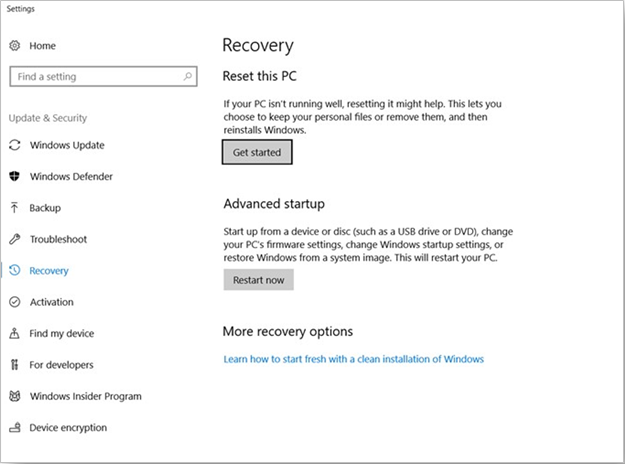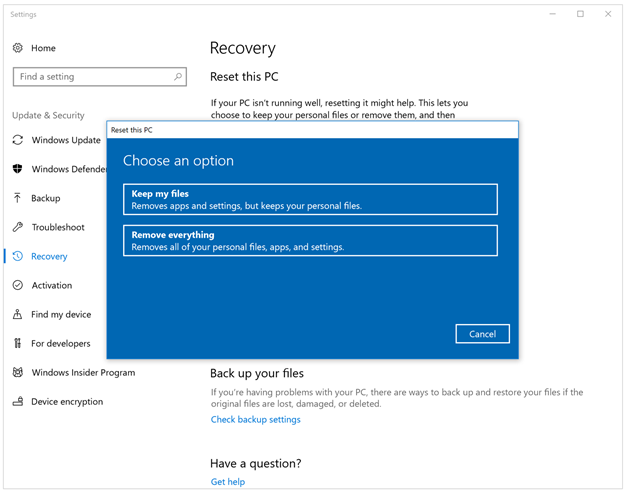- Articles
- Why the Windows 10 Recovery feature is a beau...
Table of Contents
My computer was acting up. It’s the powerful Surface Book by Microsoft, a 2-in-1 hybrid laptop and tablet tuned for high-performance computing. So, it was unusual when I noticed that Outlook, an app that is an absolute necessity for our business, kept gobbling up memory and I need to crash and restart. Not only was the sluggish performance in Outlook annoying, I found both my iCloud and OneDrive cloud storage apps began randomly telling me they couldn’t back up folders properly and the cache getting out of synch. When my screen started doing weird things that couldn’t be replicated, I finally conceded that I had to use the Windows Recovery option to reset my PC.
Windows Recovery is a built-in feature of Windows 10 that allows users to install a pristine, factory-fresh version of the operating system to their PC. Although the term “reset” often scares business users (who only see it as a kind of “nuclear option” of last resort), the fact is that Windows Recovery with Windows 10 is an elegant and easy way to restore poorly-performing Windows 10 PC to its original glory without losing any of your critical data. Believe me, I was skeptical this was true until I tried it—and it was a beautiful thing. I was able to reset my Windows, keep my crucial business data, and stay productive.
The road to recovery
To begin the Windows Recovery process, type “recovery options”in the Cortana search bar in Windows 10. The best match will be the Recovery options in System settings and that’s the one you want to click:

In the Recovery feature, you’ll be presented with the option to either “Reset this PC” or “Advanced startup.” As the descriptive text mentions, this is the best option to choose when your PC is acting up because it will keep your personal files while refreshing your copy of Windows 10.

Once you click the Get Started button, you will be given two options from which to choose:

Microsoft clearly lays out what each reset option does to your PC:
-
- Keep your files but remove and replace the Windows operating system and installed apps
- Remove all software on your PC and start over
The obvious choice here is the first one because you want to reset only the Windows operating system but keep your personal data such as Excel spreadsheets, PowerPoint slides, and artwork/audio/video files created in the Adobe Creative Suite. Before you choose, it’s good to understand why the second option makes most people nervous about performing a reset on their Windows PC.
Not just a nuclear option
The “remove everything” option is what power users (e.g. software developers, hardware engineers, and academic-minded PC enthusiasts) of the venerable Windows 7 generation would often use to fix a wide array of problems with their PCs that were difficult to troubleshoot. It was also a true “nuclear option” because it not only eliminated your ailing Windows operating system but also every business-critical software application on your PC. So, the “remove everything” option in Windows 10 is just like when users would reset a Windows 7 PC—and that meant finding every CD-ROM or DVD installation disc (remember those?) and product keys to reinstall all of your apps then reconfiguring everything on your PC with your own personalization settings. This downside to resetting a Windows PC with the “remove everything” option is so severe that only those most courageous of users with ample time would want to do it.
But when you choose the “keep my files” recovery option in Windows 10, you do not risk losing all of your documents, photos, and other personal files on your PC. This option reinstalls a fresh and 100% up to date copy of Windows 10 on your PC while keeping your personal files. As you’ve likely already noticed, there is one caveat to the “keep my files” recovery option: Even using this option means you must reinstall anything that did not come with the Windows 10 operating system.
While the recovery does keep all of your documents and files, it does not keep any of the 3rd-party software you or your IT department have installed on your Windows PC. In my case after doing the reset I had to reinstall the custom font we use for our corporate documents, Microsoft Office, Adobe Acrobat, and a few other apps we use at Amaxra. However, I was surprised the whole process took just a couple of hours to complete and the amount of reconfiguring my personal settings was minimal. The reason? Many of my account settings in not only the Windows operating system but also my Microsoft Office 365 and Adobe Creative Suite apps (among other 3rd-party business software solutions) are kept in the cloud. It was like the web-based solutions we use such as Microsoft Dynamics 365 that are served to a web browser; as long as I remember my login I don’t have to worry about losing my settings.
Cloud powered simplicity
Because all Amaxra employees use Office 365, each of their personal preferences for Microsoft Word, Excel, and PowerPoint are stored in the cloud. If our employees must reset their PC, they never lose any of their sent and received email or their calendar invitations in Microsoft Outlook because all of that data is stored in the cloud-based Microsoft Exchange Online solution. All we have to do is sign into our account and those Office 365 settings are automatically replaced on our reset PC.
One minor quibble I have about reinstalling Office 365 apps is that reinstalling the apps themselves via download will default to the 32-bit versions of the apps. However, I use the 64-bit apps so when I reinstalled Office 365 the default 32-bit versions of the apps were installed. Because there is no way to perform an in-place upgrade of 32-bit Office to 64-bit Office, I had to uninstall and reinstall all of the apps. It feels like Office 365 should have stored my personal preference for 64-bit in the cloud, so it would’ve known what I previously had and then installed accordingly. From what I gather, the majority of Office 365 users have the 32-bit version and my edge case-scenario won’t be an issue for most people.
Stay productive
The result of performing a reset of Windows 10 was that all the problems I had experienced on my PC were gone and I had minimal downtime from my business. If your organization wants to leverage the cloud to take full advantage of these game-changing capabilities, I recommend one of the Microsoft 365 plans that are available for businesses. It is an easy, affordable, and comprehensive solution for managing and securing the business-critical apps on all of your company’s devices.
